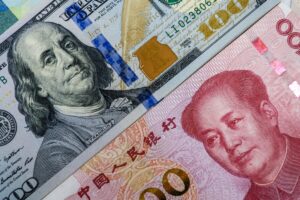In the ever-evolving landscape of global trade, the recent onset of tariffs has stirred significant upheaval, particularly between two economic titans: the United States and China. As President Trump has introduced a 10% tariff on all Chinese goods, the implications for major tech players are creating ripples that extend far beyond immediate costs and logistics.
The Heightened Tensions
Just as tensions between the U.S. and China have elevated, tech giants like Apple, Google, and Nvidia find themselves at a crossroads, facing new obstacles. On the same day that the tariff was announced, China’s State Administration for Market Regulation (SAMR) opened an antitrust investigation into Google. While specifics remain scant, this move appears to be a strategic counterpunch in a highly charged economic environment.
In tandem, reports surfaced that Apple could soon face scrutiny over its App Store practices following similar dialogues between SAMR and Apple executives. This potential investigation is not unprecedented; Apple has navigated similar challenges within the European Union and has faced allegations from the U.S. Justice Department about anti-competitive behavior. Apple, which makes substantial revenue from its App Store, could feel dual pressure from tariffs and Chinese regulatory measures.
Who’s Feeling the Heat?
Apple Inc. (AAPL):
Apple stands to be one of the most affected companies by these developments. With the U.S. tariffs directly impacting its flagship products, including the iPhone, prices could rise as high as 10%. Alternatively, Apple may choose to absorb this cost, which would directly affect profit margins. Historically, Apple has sought tariff exemptions—an option that remains ambiguous for the current landscape. The App Store investigation in China further complicates matters, though it is worth noting that this revenue stream, while significant, is a fraction of Apple’s vast revenues.
Intel Corporation (INTC):
Intel’s reliance on the Chinese market is profound, with approximately $15.5 billion of its revenue coming from China in 2024. As the company seeks to bolster its position amid a turnaround strategy, it may find itself vulnerable to any actions China might take in retaliation to U.S. tariffs. The potential for an antitrust probe could amplify these challenges, thereby disrupting Intel’s recovery trajectory.
Nvidia Corporation (NVDA):
In the case of Nvidia, intensified scrutiny is warranted. The company is already embroiled in existing probes instigated by Chinese authorities, particularly in the wake of U.S. restrictions on certain chip exports to the region. With China representing a substantial market for its AI technology, continued cooperation could be jeopardized if tensions escalate further. Additionally, Nvidia’s financial exposure to China highlights the precarious nature of its position amidst these geopolitical frictions.
Alphabet Inc. (GOOG, GOOGL):
Surprisingly, Google seems to be in a more subdued position in this conflict. Having largely exited the Chinese market years ago, its revenue from China is minimal, primarily limited to advertising sales to Chinese companies targeting foreign audiences. This absence from a major market makes Google’s antitrust concerns appear almost ironic given that most of its services are banned within China.
What Lies Ahead?
The increasing friction between the U.S. and China underscores a broader trend of rising economic nationalism, with both governments flexing their regulatory muscles. For companies like Apple and Intel, this means they must strategically navigate both tariff impacts and potential investigations that could threaten their profitability and market share.
While immediate investment strategies might seem reactive, the long-term play lies in supply chain diversification and innovation. As supply chains are reshaped in response to geopolitical realities, companies that adapt swiftly will likely emerge more resilient.
Conclusion
For investors, the current state of affairs presents both challenges and opportunities. Understanding the implications of tariffs and regulatory measures can mark the difference between a shrewd investor and a passive observer. As this narrative continues to unfold, companies must pivot quickly, and investors should keep close tabs on these developments to make informed decisions.
Staying informed and proactive in the face of shifting trade dynamics can better equip investors to navigate this turbulent landscape. At Extreme Investor Network, we are committed to providing in-depth insights and analysis that help our readers not only understand the current financial climate but also strategize for future success.

